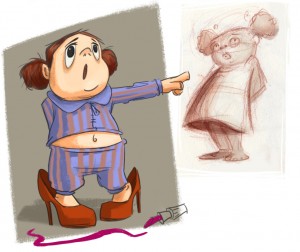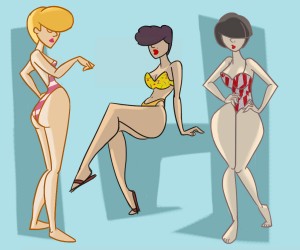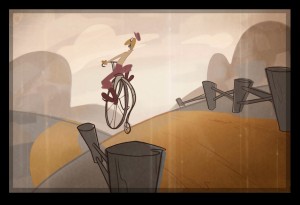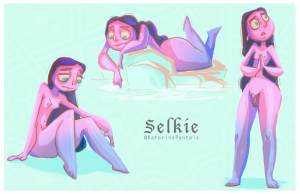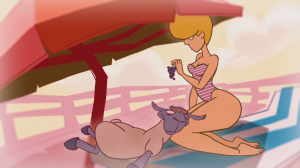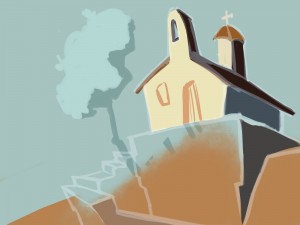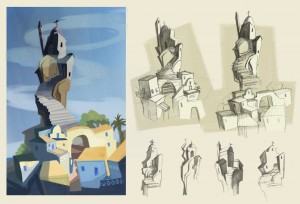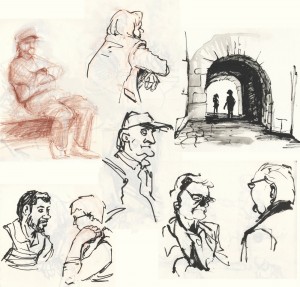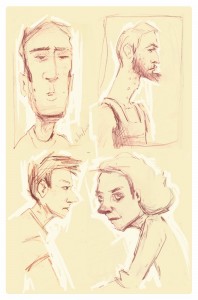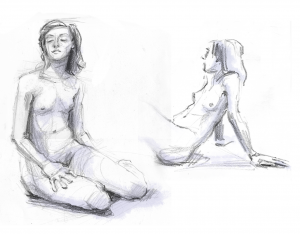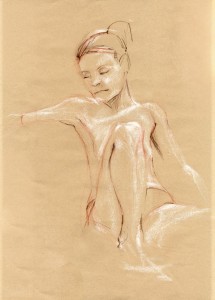
Katerina Pantela is an enthusiastic 23-year-old character animator, visual development artist and illustrator from Cyprus, currently living in Dublin, Ireland.
Having graduated Animation Production from the Arts University Bournemouth, Katerina currently works as an animator at Boulder Media for Disney XD. In her spare time, as she mentions, she likes to “draw, belly dance, watch pointless TV shows, look at other artists work, eat food that I haven’t cooked myself, go to the cinema, watch documentaries about all sorts of random stuff and read books”.
Aside from experimenting with any style she might find useful for her evolution as an artist, Katerina also documents most of her work on her blog. And if there is something I enjoy more than constantly looking for great art, that is discovering blogs where artists talk about their art. You know, those authentic posts where they share their latest sketch, way before it’s finished, and tell its genuine story, just like they were writing for you, the one reading right then and there.
Katerina’s blog is one of those candid blogs, where passion is present in every new drawing she posts – and her enthusiasm is quite contagious! Just like in this interview.
I was strongly encouraged and backed up by both my parents to pursuit my passion for drawing and they made sure I had a creative foundation and artistic education from a young age which I am very grateful for
I haven’t found this info anywhere, but I assume you are from Greece? 🙂 How did you get from there, to Dublin, what is the story?
I am from Cyprus, with Greek being my first language.
At the age of 18 and after finishing school I moved to the UK to do an Art and Design Foundation course while trying to figure out which creative pathway I wanted to follow. Finally, Illustration and Animation seemed like the obvious choices so I started applying to the most qualified universities and institutions around the UK, preparing my portfolio and hoping that one of them would take me.
After a lot of researching, thinking and attending interviews I finally got into my first choice which was Animation Production at the Arts University Bournemouth. That place ‘clicked’ with me since my first visit and the course seemed incredible. It just felt right. So there I was a year later, studying animation at the AUB and I could not have been happier. During that period I have met some of the most talented people and had the best 3 years of my academic life.
The course also gave me the opportunity to get some professional experience abroad. I got to spend 5 months in Luxembourg working for La Fabrique d’Images (editor’s note: animation studio) and 1 month in Bergen/Norway working for Bug AS (editor’s note: production company). All together I stayed in the UK for about 4 ½ years before going back to Cyprus for a while and then moving to Dublin, Ireland in September 2013.

According to your bio, you are “a young character animator, visual development artist and Illustrator”. It sounds like a lot of work, there are many skills involved. How does that work for you, how does it feel like, developing these skills?
That is a lot of work indeed! And it is definitely a challenge to try and keep them all on the same skill level.
I guess I do not always pay an equal amount of attention to each one of them but I do try to practise as often as I can, shifting site projects from time to time when my day job allows it.
What is really good though, is the fact that most of these skills are transferable. For example, when doing an illustration piece I am at the same time practising my design, composition, lighting and colour skills which also fit into my visual development skillset.
The same goes for animation. When animating a character for a certain production I get to redraw the same design over and over again, drawing it in different poses and viewpoints which kind of works like an ‘artist study’ and complements my knowledge towards character design.
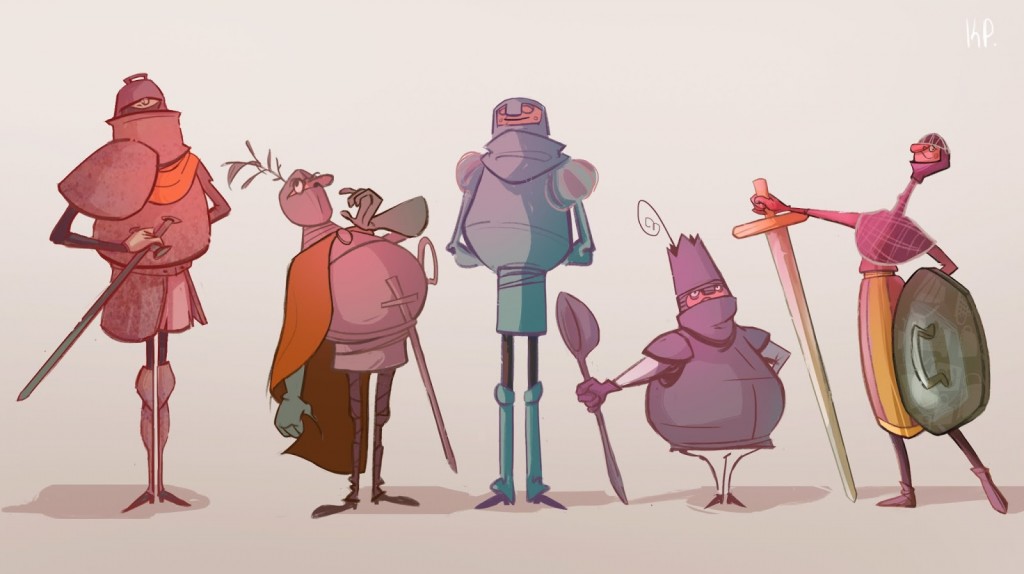
Do you feel like school is a must, in order to get to where you are now? Could you have learned all this studying by yourself (and if so, what do you think the steps should have been)?
I think for me going to art school was very important. I wouldn’t say it is a must, but it is definitely an experience I wouldn’t change for the world.
To be completely honest, I think most of the technical skills I learned at uni can be gained through online tutorials and a lot of practising on your own, especially nowadays with the web being such a massive resource supplier. You can practically train yourself if you are motivated enough.
But there are things only the art school can teach you! Learning to challenge your creative and critical thinking, finding the most efficient and sophisticated ways to research, brainstorm and generate original work, being a creative intellectual who always seeks to equally develop theory and practice, these are only a few of the things you get out of art school.
Why did you choose to study animation, what attracted you towards it in the first place?
My parents are probably the ones to “blame” for my “addiction” towards animation. Myself and my siblings were practically brought up with animated films and fairy tales. In addition, I was lucky enough to be born in a family full of artists and designers. I was strongly encouraged and backed up by both my parents to pursuit my passion for drawing and they made sure I had a creative foundation and artistic education from a young age which I am very grateful for.
Animation is an extremely complex art form that can produce wonders! That is what attracted me towards it at the first place. The fact that people could create entire worlds from scratch was astonishing. I could not even comprehend the amount of patience, skill and hard work these artists put into it. It was actually hard for me to believe that someone could make a character move and speak and act in such a charismatic way, and all that through drawings. I had to try it out and see for myself! And I am still trying!
It was actually hard for me to believe that someone could make a character move and speak and act in such a charismatic way, and all that through drawings. I had to try it out and see for myself!
You work for Boulder Media, animating for Disney XD. How long have you worked there? What does your work involve, exactly?
I have been working there since October 2013. I was offered a spot on their paid training program which led to a full time position as a character animator on Randy Cunningham 9th Grade Ninja, season 2, for Disney XD. My responsibilities involve animating a specific amount of shots per episode, from roughs to polished and cleaned up animation, under the guidance of my lead animator and the rest of the animation team.
What were you doing before working there?
After finishing my BA in Animation in 2012, I went into a 3D Computer Animation course which I completed half way before finally deciding to terminate my studies there due to finding the course unsuitable for what I wanted, even though I was doing well at it.
I decided to go back to Cyprus for a few months and used that time to explore other fields within my skillset as well as doing some volunteer work. During that period I was commissioned to work as a children’s book illustrator which was a lot of fun! When that was over, I moved to Dublin to start working for Boulder Media and be with my wonderful boyfriend.
Apart from being informative and a good way to set the foundations of a piece, drawing from observation can also be very inspiring and a way for generating new ideas and styles, which is why I think every artist should do it often
Do you draw only digitally, or on paper as well? What tools do you use?
I draw digitally and on paper, sometimes I even draw on napkins if there is no paper around. I use anything and everything I find laying around and I try not to get too attached with one tool. But I do have my favourites, and that is drawing with the Brush Pen and Chinagraph on animation paper.
Is using real life reference material in your illustrations a common practice? In other words, how much is of your work is influenced by a real subject, from your daily life?
Yes, I try to always use real life references. Before I start a new illustration, animation or character design piece I make sure all the research is there first. I usually collect images from the web or photographs I have taken myself and make mood boards out of them. For me that is a very important part of the process. My work is therefore influenced by real subjects I guess, even though I rarely do realistic looking stuff. Instead, I use real life references to extract those elements that make an illustration or character feel believable.
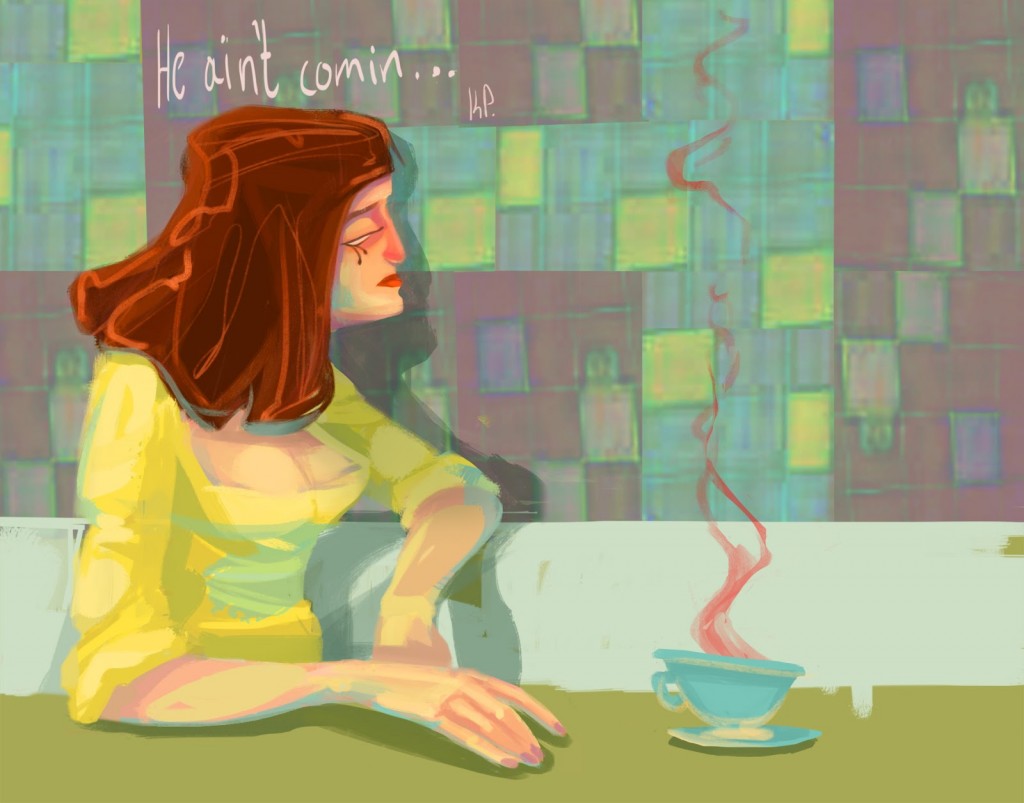
One of the sketches you posted on your blog came with an interesting observation. You said you try to “discover a more unique approach towards observational sketching, thinking about shape, form and technique, not being too afraid of drawing ‘ugly’”. Why is that, why would you advise less experienced artists to do that? How has this technique helped you?
I try to do that in order to find a “voice” in my drawings, as cliche as this may sound. I get very influenced by all the amazing work I see around the web, in books and in films, which can be a good thing, but it can also becomes an obstacle to discovering that special thing that will make your work unique and recognizable.
So I started focusing on this new way of working, which is to completely lose all expectations from each drawing I start and be surprised by the result. I do that especially when drawing from observation in order to allow my mind to extract information from real life and selectively manipulate it to describe something different. Apart from being informative and a good way to set the foundations of a piece, drawing from observation can also be very inspiring and a way for generating new ideas and styles, which is why I think every artist should do it often.
Life drawing meetups are a great way to socialize and learn from other artists that might be coming from different artistic backgrounds
Dublin is a place where more and more people gather on a regular basis, for life drawing sessions. You also participated in some of these meetups, what is this experience like? Has this helped you develop your skills?
Being a traditionally trained artist and animator, I always respected the importance of life drawing and observational drawing in general.
Life drawing was a big part of the animation course curriculum back at the Arts University Bournemouth but after finishing my BA, finding life drawing studios/sessions for adults was a bit hard, especially in Cyprus. So I was delighted when I discovered the one I am attending now in Dublin, although I wish I had the time to do it more often.
Life drawing has definitely been a huge factor for improving my skills, especially when it comes to animation and character design. Life drawing meetups are also a great way to socialize and learn from other artists that might be coming from different artistic backgrounds. It is interesting to see how a fine artist or a comic book artist might depict the same life model in a different way and get to analyse and study each others different approaches.
I read on your blog that you also joined a speed-painting group on facebook, where you have 30 minutes to create a themed painting from scratch, daily. That sounds a lot of fun, what is that like? Is it also a good exercise, having to finish a piece in such a short time frame?
I joined that group in order to keep myself motivated when I have a hard time finding inspiration and I have liked it so far, even though I do not always feel confident with sharing my work. There is so much talent in that group and I often find it intimidating trying to keep up with all those amazing artists. It is however a great way to keep the creative juices flowing and sharpen my technical skills.
The time constraint makes you focus on what is important in what you are trying to describe in a painting. Not that much time for clean up and polishing but instead you really learn to pay attention to the fundamental elements of a piece, like the composition, the mood and perspective, shapes and the tonal values. Details are usually loosely indicated and the lighting is simplified. You also learn to be less precious and treat each painting as an exercise.
Nothing has to be perfect as long as you have learned something from doing it. In addition, it is a good way to practise your speed and efficiency, coming up with new techniques that will speed up your workflow.
Many of your drawings have a very cartoonish vibe, very funny and expressive. Is there a recipe to being able to draw in this style (aside from the many years of practice, without which I’m sure it’s not possible)? What would be the process of turning a normal portrait (for example), into a cartoonish one (just like you did with your beautiful self-portraits posted on your blog)?
Well, I wouldn’t say there is a recipe for it, not that i know of, but there is a specific thought process I follow when I am producing those drawings.
For instance, I usually study my “object” for a while to get the quality information I need, and then I try to extract the main details and features that make that face special. I try to keep it simple and be selective with the amount of lines I use while managing to get a convincing effect. I also try to add some emotion into it, maybe a characteristic facial expression and a bit of exaggeration.

No matter how much you think you suck, do not give up on your art
What are your future plans? What do you dream of doing, in the following years, professionally?
I am trying not to be too “strict” with my future plans, especially because my plans almost never happen in the way I have in mind, haha. But, I know I would love to be an Art Director at some point in my career. I do also want to get more involved with children’s book illustration but without giving up my passion for animation.
What would you advise aspiring illustrators/animators, in order to learn and grow?
The best advice I can give is the same advice I repeat to myself: No matter how much you think you suck do not give up on your art. Get the bad work out of your system and you will see your art grow and with it so will your skills and critique abilities.
A tutor of mine used to say, “You need 10% of talent and 90% of hard work to become a good artist”. So, work, make mistakes and then work some more! The more you do it, the faster you will cover the gap between “getting there” art and good art.
Never stop learning and teaching others. Exchange your knowledge and creative experiences with your art colleagues/ classmates/ friends as those tend to be the best people to learn from.
Follow more Katerina’s work and notes on her: blog | facebook | twitter | animated buzz
